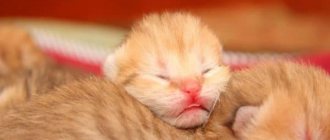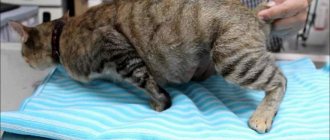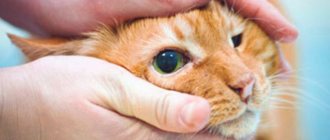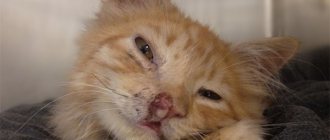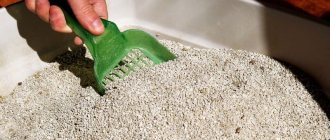Pregnancy of a pet is a joyful and important event. Cats become sexually mature by 6-8 months and, if the owner does not plan to sterilize her, you need to be prepared for childbirth. When a female gives birth for the first time, it is especially exciting.
Nature made sure that cats did everything on their own, but sometimes it needs to be stimulated. Street animals often find a secluded place and do not bother their owners. But helping a cat give birth in a city apartment is often necessary.
How to prepare? What to do when your cat doesn't push well? What drugs should I use? When to see a doctor? What to do if a cat gives birth for the first time? We will answer these and other questions further.
Stages of pregnancy
Short-haired and hairless breeds bear kittens for 55-65 days, long-haired breeds - up to 75 days. Pregnancy time also depends on the number of babies in the womb. The more kittens, the faster the birth will occur. However, if there are 1-2 cubs in the litter, then they can be expected with some delay.
ATTENTION! Sometimes one meeting with a male is not enough. Conception can occur a third or subsequent times, so it is difficult to determine the exact date of pregnancy at home.
Let's trace the stages of pregnancy for clarity:
- By the 20th day, the cat’s nipples become rounded, turn pink, and may peel. The female moves less and avoids high surfaces. He prefers sleep to active games and eats heavily several times a day. The belly increases slightly, but in long-haired breeds this is not noticeable. When palpating, you can feel the developing fetus, but this should be done carefully, because hasty actions will harm both the cat and the baby.
- From day 40, the fetus begins to actively develop. Gradually, limbs, head, and tail are formed. Internal organs are being formed and the nervous system is developing. Subsequently, the fetus acquires features inherent in cats, and also acquires sparse hair. The cat gradually loses its appetite.
- By week 6, the fruits descend into the abdominal cavity and stretch out. The belly is noticeably rounded, but if there are only one or two kittens, the changes are practically invisible. The abdominal cavity increases noticeably and takes the shape of a pear.
- After the 50th day, future kittens move actively. If there are many of them, then there is not enough space for everyone. The cat is experiencing discomfort. The expectant mother experiences vaginal discharge and colostrum appears from the nipples. The pelvis relaxes, and any day now the cat will give birth. She restlessly walks around the apartment or lies for a long time in a pre-prepared nest.
Maine Coon, British, Persian and Sphynx cats often require owner intervention and, in rare cases, veterinary intervention.
Stimulation of labor in cats and preparation for it
Many owners who have got a cat and are faced with its first birth are wondering: how to help a cat give birth for the first time? The question is very relevant and correct, since when giving birth for the first time, an inexperienced cat panics and fusses - after all, this process is new to her and she can only guess at a natural level what exactly she needs to do.
Before giving birth, the cat begins to meow hysterically
The cat's behavior during this period may change beyond recognition. She may begin to rush around the house, meow hysterically and rub against her owner, calling him for help.
But what can the owner do? After all, he cannot know in advance how his pet will react to the kittens and to the process of delivery itself; there is a high probability of psychological trauma and physiological disorders in the body.
How a cat behaves during childbirth, especially the first, largely depends on the individual characteristics of the psyche and the body as a whole. Some individuals literally require the owner to be constantly nearby, need stroking and affection, while others, on the contrary, hiss and scratch the person, clearly making it clear that he should not come close. In such cases, all that remains is to observe and hope that the cat will cope on its own.
If your cat is acting aggressively, call your veterinarian
It happens that all the due dates set by the veterinarian for a cat pass, but the female is not going to give birth. How then can you help a cat give birth at home, because kittens gain weight and exhaust the cat more and more, foreshadowing problems with passage through the birth canal.
In such cases, only a veterinarian, but in no case the pet owner himself, can decide whether it will be necessary to help the cat give birth and how exactly to do this! For example, folk remedies used during childbirth for a “difficult” cat can provoke an even longer process, which will cause a protracted delivery, poor pushing, and bleeding.
The introduction of hormonal drugs such as Oxytocin or any other analogues for an unprepared cat can be the beginning of the end - a rupture of the cervix will occur. That is why the cat is examined in advance by a veterinarian-obstetrician and, based on the tests and data obtained, decides which drug should be used.
Preparation
Preliminary measures will not be superfluous, although most breeds cope well with pregnancy on their own. So what should you do if your cat gives birth for the first time?
First, we set up a nest. A regular cardboard box is perfect for this. We put a diaper or any other fabric on the bottom for convenience. Experienced owners recommend using several layers of soft paper or baby diapers. Special houses for cats are suitable for nesting. The main thing is that the expectant mother has free access.
Secondly, the cat should build a nest in a warm, ventilated room. We exclude drafts and the presence of other animals. We exclude the toilet and bathroom. The ideal option would be a small room where the cat will not be disturbed. For example, a storage room.
Thirdly, in order for the pet to successfully give birth, it is provided with food and clean drinking water. All this is placed near the nest or place where the cat prefers to sleep. Presumably she will give birth there.
What items will be needed to help the cat, stimulate and speed up the process? The list may change, but if the owner has most of the above, then half the battle is already done:
- Disposable diapers and wet wipes.
- Scissors.
- Disposable syringes and a number of medications to eliminate complications.
- Vaseline oil to stimulate the vaginal muscles.
- Surgical (or silk) thread to tie the umbilical cord.
- Iodine, brilliant green, disinfectants.
Organization of the “family nest”
On average, pregnancy in cats lasts 65 days. The period may vary from 60 to 70 days. Childbirth before and after this period can be caused by pathologies (impaired pregnancy, fetal death, etc.) and be accompanied by complications. Therefore, it is important to closely monitor the condition of the animal during pregnancy, and especially in the last stages. After the 60th day of pregnancy, it is necessary not to leave the cat alone for a long period of time, so as not to miss the onset of labor.
Childbirth is a natural process. Sometimes it causes even more stress for the owner than for the pet itself. The cat's instincts will allow her to perform all the necessary manipulations, however, a person should monitor the process and intervene only if necessary.
Before the birth itself, it is important to provide the animal with an appropriate place. The cat itself will look for a secluded corner and spend a lot of time there. Sometimes the animal is huddled in the farthest and darkest corners, to which there is no access, and in an emergency it will not be possible to quickly provide help. Therefore, it is better to organize a “family nest” yourself. To do this, it is recommended to use special baskets for cats or use a cardboard box. One wall of the box is cut off so that the pet can enter it without any extra effort. At the same time, the remaining side should become an obstacle for the kittens to prevent them from crawling out.
The place should be cozy, spacious enough, and located in a quiet and peaceful part of the house. It should be remembered that the mother and offspring will spend the next few weeks here, and at first they will not be disturbed.
Causes of problems
Taking a dip at home is quite easy. It doesn’t matter if it’s a village house or a city apartment. But in some cases, the pregnancy period has passed, and the cat still does not give birth, although all the signs are obvious. The kittens will continue to grow, taking away strength and energy. The larger the fetus, the more difficult the birth will be. They should not be tightened.
Let's list the main reasons why a cat is unable to go into labor on time:
- malposition;
- the kitten is too big;
- narrow pelvis;
- insufficient amount of lubricant;
- incomplete dilatation of the cervix;
- age of the cat;
- mechanical injury;
- inflammation of the genital organs;
- the cat is overweight;
- breed characteristics - dwarf, Himalayan;
- anatomical properties of the vaginal vault.
Weak labor activity stands out. There are two main types. The first is a slight tone of the uterus. It is caused by a lack of the hormone oxytocin. In rare cases, calcium. The second occurs when labor lasts more than a day, the cat has lost a lot of strength and can no longer push.
To avoid the problems described above, a pregnant cat is taken to a veterinarian before giving birth. He conducts examinations and makes recommendations if any of the listed anomalies are detected. In rare cases, hospital observation is required to prevent the death of a cat and its offspring. This could be a clinic in Moscow or a good provincial one.
What not to do during childbirth
In the desire to help a giving birth cat, it is important not to harm. There are a number of actions that are prohibited. What you shouldn't do:
- do not press on the stomach, this will cause pain to the cat and harm the kittens inside;
- do not pull the umbilical cord so that it does not break or cause a hernia in the cat;
- do not burst the bladder if the woman in labor is ready to do it herself;
- Do not give injections without your veterinarian's approval and do not use medications to induce normal labor.
- do not use instruments without sterilization to avoid infection;
- Do not take kittens away from your cat immediately after birth.
How to induce labor at home
It should be understood that there are a large number of drugs on the market. In any case, it is better to consult a veterinarian who will take into account the individual characteristics of the cat. A number of drugs are excellent at inducing and accelerating the birth of your pet.
Let's look at the main medications that are used for stimulation:
- Oxytocin. Perhaps the main drug used in difficult childbirth. However, incorrect dosage can lead to bleeding and cervical rupture. Before use, consultation with a veterinarian is required!
- Traumatin. Used as an analgesic and prophylactic for difficult childbirth. Travmatin is effective in healing wounds with damage to the genital organs. Prevents infection of the uterine cavity by pathogenic microbes.
- Gamavit. Directly stimulates the muscles of the uterus. Often used in prolonged labor and difficult cases.
- Calcium gluconate. A lack of this element often leads to complications along with oxytocin. The drug enhances labor activity as it acts. It also provokes the formation of milk. Used to relieve nervous tension after childbirth.
Lack of calcium leads to the development of eclampsia - acute postpartum depression, which negatively affects the nervous system and causes severe convulsions. In advanced cases it leads to the death of the animal.
Veterinary practice knows cases when labor can be induced without the use of medications. Let us note two main methods.
Option one
The owner puts on gloves. Puts the cat in a position where she goes to the toilet "in large quantities." Next, massage the abdomen in a circular motion. After a couple of minutes, dip your finger in Vaseline oil and insert it into the cat’s vagina about a centimeter. Circular movements are repeated again. Mechanical actions help stimulate and speed up labor.
Option two
When oxytocin is contraindicated for a cat for some reason or the owner does not risk using it, then the following method will come to the rescue. Using a disposable syringe, mix 2 ml of ascorbic acid, 4 ml of glucose, 4 ml of calcium gluconate. We administer intramuscularly or intravenously, but only after the female has given birth to her first baby.
For every 5 kg of weight, 1 ml of the resulting solution is sufficient. It is also used after childbirth as a prophylaxis against eclampsia.
Help with normal childbirth
Childbirth is a very intimate process, so the owner must provide his pet with a calm environment. If childbirth proceeds normally, then any active intervention is not recommended; nature itself will do its job.
In case of slow labor, after the fetus has already appeared in the birth canal, you can slightly speed up its progress:
wait for contractions and pushing (their onset can be understood by the characteristic contractions of the abdomen); slowly and carefully pull out the kitten, carefully grasping it with your fingers through a napkin; alternately, just a little, rotate the kitten left and right.
Stages of the procedure
Specialists note several stages that precede the birth of kittens. The cat walks restlessly, the babies are actively moving in the stomach.
The first stage of labor begins. It lasts up to 24 hours. The cat's body temperature drops by 2-3 degrees. This is a natural process. The cat actively licks the nipples or genitals. In some cases, vomiting is observed. It is better to transfer the expectant mother to a previously prepared nest. There she will feel safe and prepared for childbirth.
The cat's water breaks and her pulse quickens. Breathing is occasionally interrupted. The contractions began. The pet meows loudly, sometimes turning into a scream. The owner calms the cat down by talking and lightly stroking the belly.
The second stage begins. The abdominal and diaphragm muscles are activated. The cat is pushing hard and the baby is gradually moving forward. The amniotic sac partially ruptures and fluid flows from the vagina.
Many owners are interested: is a kitten born feet first or head first? In this, cats copy humans. Like a human baby, a kitten is born head first. But it is worth noting that birth with the pelvis or paws forward should not cause concern to the owner. This is natural for cats.
The mother licks the baby, freeing it from the amniotic sac. Cats often eat this afterbirth. It is rich in vitamins and minerals. But a large amount of afterbirth eaten causes indigestion. The optimal quantity for a female is 2 pieces. In most cases, the cat chews the umbilical cord on its own.
ATTENTION! The number of afterbirths exactly corresponds to the number of kittens. Sometimes their number does not match. This means that one of the placentas remained inside the uterus. It must be removed to prevent inflammation of the genital organs in the future.
The final, third stage comes into force. The animal's uterus comes to rest until the next kitten appears. The break between births lasts from 10 to 60 minutes. The cat can drink and rest a bit.
The time of birth is an individual value. But if they continue for more than 24 hours, you should contact your veterinarian.
How do you understand that something has gone wrong and the animal needs help?
Most often, cat birth goes well, and the animal gives birth on its own. It happens, however, that a pet needs help both during lambing and after the birth of kittens. This is due both to the physical condition of the pet and to its attitude towards its own offspring.
If a cat gives birth for the first time, she needs constant attention from her owner.
Discharge after childbirth
If your cat bleeds profusely within 10 minutes after lambing, you should call a veterinarian. This condition is often caused by a rupture of the uterus or vulva. Moderate bleeding within 2 days after lambing is considered normal, provided there is no unpleasant odor, mucus or pus. If the discharge does not disappear for a long time, you need to contact a veterinarian.
A cat who gave birth has a big belly
A large belly in a new mother may indicate an accumulation of gas and feces caused by constipation, or a helminthic infestation. Another reason for an enlarged abdomen may be uncompleted childbirth. To find out whether the fetus remains in the uterus, you need to palpate the cat's belly. With an incomplete birth, the muscles remain tense, and the kitten can be easily palpated. If the baby is moving, you can wait up to 24 hours. If there is no labor, you need to urgently take the cat to the veterinarian.
Lack of milk in a cat
The absence or insufficient amount of milk in a cat who has given birth may be associated with stress or aggressiveness of the new mother. The owner is required to create a calm atmosphere for his pet, in which she can express her maternal instinct and feel safe.
The cat does not approach the kittens
Why doesn't a cat approach kittens after giving birth? There may be several reasons. In cats, the maternal instinct “wakes up” later than the sexual instinct, so young mothers can ignore their offspring. For this reason, you should not allow the animal to mate until it reaches 2–3 years of age. What other reasons could there be for a mother to ignore her offspring? A few examples:
- lack of milk;
- developing mastitis, in which sucking kittens causes pain to the mother;
- eclampsia (acute calcium deficiency);
- stress (can be caused by the appearance of another pet in the house or the location of a box with kittens in a passable place);
- non-viable offspring.
Often cats do not want to approach their offspring if the kittens are often touched by strangers. Babies lose their original smell, which provokes the extinction of the cat’s maternal instinct. You should not touch the kittens unless necessary; it is better to leave the family alone.
Sometimes the mother does not accept all the babies, rejecting one of them. This is due to the fact that the cat senses its non-viability. In this case, it happens that the mother mistakes the kitten for a weak one with a low body temperature. In this case, it makes sense to pick up the newborn, wrap him in a soft towel and keep him warm. After this, return the baby to the mother. Perhaps the situation will change and the cat will accept the kitten back.
If no method has proven effective, and the cat still does not approach the babies, the owner will have to take on maternal responsibilities. You need to stock up on kitten formula, pipettes, and bottles. Babies should be placed in a warm, dry place and given a heating pad to replace the warmth of the mother's body.
What kind of help will you need?
So, we figured out how to induce and stimulate labor. But in some cases complications may occur. You will need the owner's help. Let's look at the most common cases and specific actions. It is especially useful for people to know when a cat gives birth for the first time:
The fetus is large and does not pass through the uterus
We have found that it is preferable for a kitten to be born head first. There is nothing wrong with walking feet first, but it often causes complications for the cat. What to do if the fruit is large?
We put on gloves, having previously lubricated our fingers with Vaseline oil. We insert a finger into the vagina and feel the folds of the kitten’s paws. We move the baby from side to side, trying to stretch the limbs forward. We grab the paws in the area of the shoulder joint.
Sometimes the baby is far from the exit of the uterus. We provoke contractions in the cat by stretching the vagina.
The cat did not chew the umbilical cord
It is worth waiting 10-15 minutes; if the woman in labor does not take any action, then you need to help her. We squeeze the umbilical cord with two or three fingers at a distance of 3-4 centimeters from the kitten’s belly. We tie it with silk or surgical thread. We take sterile scissors in our hands. Surgical ones are better. We cut the umbilical cord. We treat the cut site with an antiseptic.
The kitten is not released from the amniotic sac
We wait one or two minutes and cut it ourselves. We take out the kitten and wrap it in cloth. We hold our head and bend our body so that our knees reach our chests. We perform the manipulations several times. Breathing should resume. If it does not appear, then perform artificial respiration. If necessary, remove amniotic fluid from the nose and ears with a pipette.
Kittens are still born
It’s a scary situation, but we don’t lose our composure. Sometimes severe contractions, low temperature or an abundance of mucus in the nasal cavity lead to the fact that the kitten only appears dead. We dry the baby. We clear the airways, turn the head down and gently shake. Next we put it on the mother’s chest.
The cat definitely gives birth to dead pets one after another. We palpate the female's belly. If one or two fetuses are felt, then immediately contact the veterinarian. A caesarean section may be required.
Can't give birth
If the female pushes weakly, then we use oxytocin, calcium gluconate or a solution of ascorbic acid and glucose. If the drugs do not help, then immediately contact the veterinarian. Resuscitation may be required.
The cat may bleed. If it continues for a long time, you should contact your veterinarian. The same applies to unpleasant vaginal discharge. There should be no sudden drop or rise in temperature.
If contractions last more than two hours, but labor has not begun, contact the clinic. This could be Moscow or any other city. It happens that two fruits try to pass at once.
Especially during the first birth, it is better not to take risks and seek help from specialists. Any complication will negatively affect the pet’s health. To the point of being unable to give birth again.
We use medications only after consultation with a veterinarian. It is good if another family member or friend provides assistance during childbirth.
Signs of the end of labor
Not all and not always cat owners know what signs indicate the end of activity.
After forty minutes, the mother’s belly becomes soft.
- The first symptom is active care of the offspring. The animal diligently licks the kittens, purrs, and feeds.
- The pet breathes evenly, the pulse and heartbeat are stably rhythmic and do not go beyond physiological parameters.
- After a short time, the cat shows interest in food and drink. The pet can get up from the nest and leaves its brood for a while.
- After forty minutes, the mother’s abdomen becomes soft; palpation does not reveal any lumps.
- However, the uterus may remain in good shape for some time, which can be mistaken for a kitten.
- In this case, you should not squeeze the cat’s stomach too much; you should place both hands on the sides of the animal and carefully move along the ribs.
- It is recommended to check after the forty-minute period has expired.
- An additional sign is the cat’s calm behavior, but due to the fact that some mothers behave calmly even during childbirth, this sign is not a 100% guarantee.
Can a cat not give birth to all kittens at once?
Bloody discharge after childbirth may indicate the presence of an unborn fetus.
If you suspect that a fetus remains in the mother’s womb, you should carefully observe the animal’s behavior .
- In such cases, the pet does not change the previous position, lies in the same place, and does not show interest in the babies or is very reluctant to care for them.
- Appetite and thirst are absent.
- Periodic pushing may occur.
- On palpation of the abdominal cavity - abdominal tension, muscle tone.
- Increase in body temperature throughout the day.
- Continuous bloody discharge from the vulva with a strong foul odor.
When to call the vet
Keep your veterinarian's number handy. You may need to seek qualified help at any time if something goes wrong. Delay during childbirth in a difficult situation is fraught with the death of both the kittens and the cat itself.
An urgent call to the veterinarian is required if:
- a kitten cannot be born for more than an hour;
- the kitten is stuck, walking incorrectly, and you cannot help the animal;
- The cat’s body temperature is too high or, on the contrary, has decreased;
- a liquid with an unpleasant odor and a strange color is released from the vulva;
- the cat has heart palpitations;
- the cat is unable to move, labor is weak or absent.
Call a specialist if you have any doubts, to be on the safe side, at least consult by phone.
The consequence of a difficult birth in a cat can be various complications. It is not possible to diagnose and treat them on your own. Therefore, a cat that has given birth should be shown to a veterinarian within a week and, if necessary, examined.
When delivering a cat at home, maintain composure. Fluffy mom sensitively reads your mood. Act clearly and correctly, and soon newborn babies will delight both of you.
Interesting topics
What else to read:
- Breeds of dogs that love catsContents of the articleThe main breeds of dogs that are friends with catsDogs that can.
- Why do cats bite Contents of the article Errors in handling cats Physiological reasons Educational fight against aggressive ones.
- How to make your home safe for a catContents of the articleToys that are dangerousIndoor plantsUnlocked windowsChemical hazardElectrical wiresHousehold appliances Starting.
- Comfortable holiday in the country with your beloved cat Contents of the article Arguments of opponents of holiday with a pet in the country Preparing for the trip.




